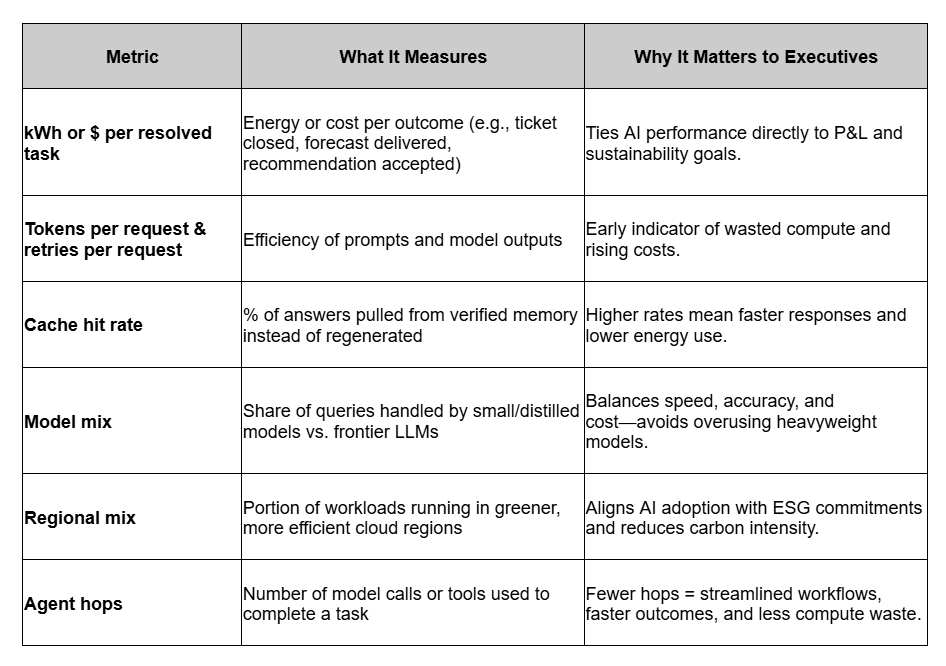The Carbon Footprint of AI: Practical Steps to Make LLMs Sustainable
October 21, 2025
8 min. reading time
AI’s growth—and its environmental bill
Gen AI adoption is moving fast. AI image generators, AI text generators, AI video generators, and AI agents are no longer experiments—they are shaping daily operations. For many organizations, this shift is creating measurable value in customer experience, cycle time, and decision-making.
But every prompt has a price. Training and running large AI models consumes enormous amounts of compute power and energy. McKinsey estimates that data centers could account for up to 4% of global electricity demand by 2030, with AI workloads driving much of that growth. For leaders, this means AI’s carbon intensity is no longer a technical detail—it’s a boardroom issue that touches cost, risk, and reputation.
The opportunity is clear: design AI to deliver results with fewer wasted tokens, fewer retrains, and fewer duplicative runs. In doing so, you reduce your environmental footprint while unlocking faster ROI.
Where the hidden waste sits
- Training & fine-tuning: Retaining multiple vendor-specific models means retraining the same data repeatedly. That’s time, money, and energy wasted.
- Inference at scale: Millions of prompts across employees, customers, and agents compound quickly. Without discipline in prompt engineering or routing, energy and spend balloon.
- Data pipelines: Inefficient ingestion and redundant jobs inflate compute use before an AI model ever generates content.
Executives don’t need to master the physics of GPUs—but they do need visibility into where the waste hides and how to measure its impact on the P&L.
Four business-first moves to cut cost and carbon
1. Smarter prompts, smaller footprint
In a healthcare environment, clinicians were bogged down searching through product catalogs during appointments. Instead of scaling up model size, the solution was smarter prompt engineering: vectorized catalogs and in-flow prompts embedded directly into the exam screen. The impact was twofold—more accurate treatment plans and less compute wasted on long, repetitive queries.
Standardize prompts for your highest-volume tasks. Insist on structured outputs like JSON agents, not prose, so downstream systems consume answers without extra parsing or retries.
2. Consolidate into an agentic AI fabric
In one enterprise, HR and IT teams ran multiple chatbots—each hitting different LLMs, each consuming redundant cycles. By consolidating into a single Agentic AI assistant trained on policy and connected to ERP, HRMS, and ITSM, the company saw significant productivity gains with fewer total model calls.
Think of it as cloud cost optimization for AI. Default routine queries to smaller models; escalate to a frontier LLM only when the task demands it. Every unnecessary escalation is carbon and cost wasted.
3. Stay model-agnostic to avoid retraining traps
A global manufacturer faced exploding multimodal data volumes. Locking into one vendor’s ecosystem risked retraining cycles with each new model release. The answer was a platform-independent control plane, complete with knowledge bases, lineage, and automated retraining for RAG. This allowed seamless swapping of models without repeating energy-intensive training.
Ask if your AI fabric lets you change models without rewriting workflows. If not, you’re paying twice—for compute and for carbon.
4. Optimize data-to-AI pipelines
One retailer discovered that “phantom inventory” was driving stockouts and wasted re-orders. By modernizing data pipelines and applying predictive AI, they cut losses while reducing unnecessary compute. Cleaner upstream data meant fewer downstream model calls—proof that sustainability and profitability align.
Demand co-location of compute and data to cut cross-region energy drag. Push for incremental processing, not monolithic nightly jobs.
What “better” looks like in practice
At Kloud9, we’ve seen first-hand how rethinking design choices creates both business impact and sustainability gains:
- Clinician workflows: By embedding in-flow prompts and a vectorized catalog into the exam process, we delivered shorter, more precise generations. The result: better care plans for patients, less time wasted for practitioners, and fewer unnecessary compute cycles.
- Corporate services: In HR and IT, fragmented chat tools were replaced with a unified Agentic AI assistant. Employees got faster, more accurate answers, while the enterprise cut redundant inferences—lowering both operating cost and carbon footprint.
- Industrial operations: A model-agnostic control plane with lineage and automated retraining allowed global operations to avoid repetitive fine-tuning. Leadership gained audit-ready transparency while eliminating energy-intensive redundancy.
- Retail supply chains: Predictive AI built on clean, governed data flagged stockouts before they happened. That meant higher sales, fewer costly re-orders, and no brute-force overstocking—profitability up, waste down.
Across industries, the pattern is consistent: business outcomes improve, costs come down, and the carbon intensity of AI workloads shrinks.
Metrics for the Executive Dashboard

A 90-day action plan
Days 1–30: Baseline & fast wins
- Audit top 10 Gen AI use cases by volume and spend.
- Standardize prompts; enforce structured outputs.
- Enable caching for repeatable queries.
Days 31–60: Architectural shifts
- Implement an agent router: default to small models, escalate only when needed.
- Consolidate overlapping bots into a single agentic AI layer.
- Co-locate compute with data to reduce cross-region drag.
Days 61–90: Sustainability by design
- Introduce carbon-aware scheduling for training and fine-tuning.
- Shift workloads to regions with cleaner grids.
- Launch the executive AI sustainability scorecard.
Your Partner in Agentic AI
For CEOs and CIOs, the conversation around AI has shifted. It’s no longer just about what Gen AI can do—it’s about how it does it. Organizations that cut waste in prompts, stay model-agnostic, and streamline their data pipelines will see lower costs, lower risk, and lower carbon intensity—all while moving faster than competitors.
Every AI image generator, AI text generator, AI video generator, and AI agent is part of this equation. The leaders who act now will build AI ecosystems that scale profitably and responsibly—earning trust from shareholders, employees, and customers alike.
Ready to see your baseline?
Kloud9 helps executives measure the true cost and carbon footprint of Gen AI. In just 90 days, we’ll show you where waste hides, how to fix it, and how to scale responsibly.



